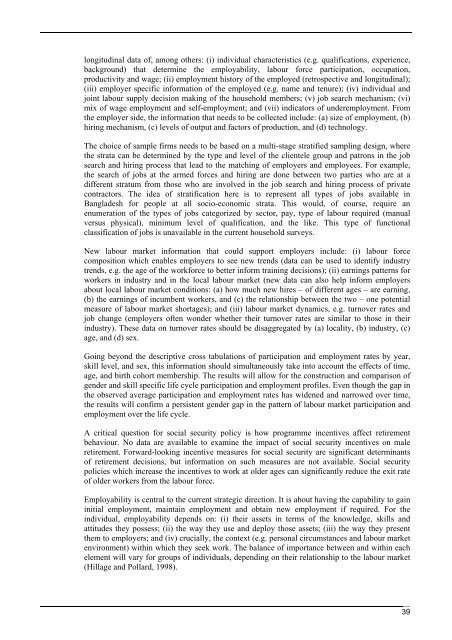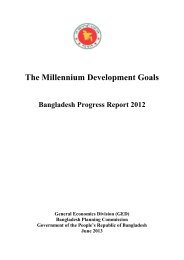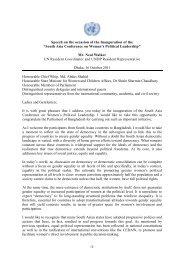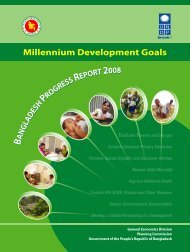extensive evidence-based research <strong>on</strong> the labour market issues at the aggregate, household aswell as <strong>in</strong>dividual levels <strong>in</strong> cross-secti<strong>on</strong>s <str<strong>on</strong>g>and</str<strong>on</strong>g> over time.Labour market research <strong>in</strong> <strong>Bangladesh</strong> is limited by lack of adequate labour market <strong>in</strong>formati<strong>on</strong><str<strong>on</strong>g>and</str<strong>on</strong>g> database system. However, c<strong>on</strong>struct<strong>in</strong>g a comprehensive database may not necessarily payoff <strong>in</strong> terms of research output <str<strong>on</strong>g>and</str<strong>on</strong>g> policy guidel<strong>in</strong>es. It is rather advisable to f<strong>in</strong>d researchpriorities <str<strong>on</strong>g>and</str<strong>on</strong>g> come up with an effective survey design <str<strong>on</strong>g>and</str<strong>on</strong>g> an ec<strong>on</strong>omic set of data po<strong>in</strong>ts thatwould be <strong>in</strong>strumental <strong>in</strong> arriv<strong>in</strong>g at the policy implicati<strong>on</strong>s. With this end <strong>in</strong> view, <strong>on</strong>e can th<strong>in</strong>kof several important regularities as well as peculiarities of the labour market <strong>in</strong> <strong>Bangladesh</strong> thatshould be taken <strong>in</strong>to account <strong>in</strong> design<strong>in</strong>g the data collecti<strong>on</strong> process.First, while unemployment is usually viewed as an <strong>in</strong>dicator of labour market performance, <strong>in</strong><strong>Bangladesh</strong>, underemployment is no less of a problem primarily because the poorest peoplecannot afford to rema<strong>in</strong> unemployed for the sake of their survival. Hence, job creati<strong>on</strong> shouldhave the objective not <strong>on</strong>ly of provid<strong>in</strong>g new jobs, but also of exp<str<strong>on</strong>g>and</str<strong>on</strong>g><strong>in</strong>g capacity to employadditi<strong>on</strong>al hours of those who are underemployed. The exist<strong>in</strong>g database, however, does notallow <strong>on</strong>e to fully dist<strong>in</strong>guish the underemployed from the fully employed. The LFS shouldcollect <strong>in</strong>formati<strong>on</strong> <strong>on</strong> the <strong>in</strong>dicators of underemployment, such as, actual daily/weekly/m<strong>on</strong>thlyhours an <strong>in</strong>dividual is employed, the number of hours he/she is will<strong>in</strong>g <str<strong>on</strong>g>and</str<strong>on</strong>g> able to work, thenumber of jobs an <strong>in</strong>dividual is work<strong>in</strong>g at simultaneously, the actual <str<strong>on</strong>g>and</str<strong>on</strong>g> expected earn<strong>in</strong>g of<strong>in</strong>dividuals <str<strong>on</strong>g>and</str<strong>on</strong>g> households, <str<strong>on</strong>g>and</str<strong>on</strong>g> most importantly, <strong>in</strong> what capacity an <strong>in</strong>dividual isunderemployed. Analysis of the <strong>in</strong>dicators of underemployment would allow <strong>on</strong>e to identify theexist<strong>in</strong>g labour supply capacity of the ec<strong>on</strong>omy that is readily available but underutilized. Giventhe background <str<strong>on</strong>g>and</str<strong>on</strong>g> labour market experience of the underemployed, we can identify the sectorswhere employment capacity needs to be exp<str<strong>on</strong>g>and</str<strong>on</strong>g>ed to absorb this underutilized resource.Sec<strong>on</strong>d, the expansi<strong>on</strong> of employment capacity of the employers is, however, limited by thedem<str<strong>on</strong>g>and</str<strong>on</strong>g> side of the labour market, such as productivity <str<strong>on</strong>g>and</str<strong>on</strong>g> aggregate dem<str<strong>on</strong>g>and</str<strong>on</strong>g> for output <strong>in</strong> themarket <strong>on</strong> which there is no <strong>in</strong>formati<strong>on</strong>. So, while <strong>in</strong> the short run, <strong>on</strong>e can th<strong>in</strong>k of exp<str<strong>on</strong>g>and</str<strong>on</strong>g><strong>in</strong>gemployment capacity with<strong>in</strong> the exist<strong>in</strong>g structure of employment, it may not necessarily workout <strong>in</strong> the medium or l<strong>on</strong>g run. One needs to identify the <strong>in</strong>adequacies of skill <str<strong>on</strong>g>and</str<strong>on</strong>g>competitiveness of the labour market participants as dem<str<strong>on</strong>g>and</str<strong>on</strong>g>ed by the employers for whichadequate <strong>in</strong>formati<strong>on</strong> is necessary. Then resources can be channelled to those areas foreducati<strong>on</strong>, tra<strong>in</strong><strong>in</strong>g <str<strong>on</strong>g>and</str<strong>on</strong>g> skill formati<strong>on</strong> of labour market participants. It is a medium to l<strong>on</strong>g-runc<strong>on</strong>siderati<strong>on</strong> because there is a time lag between the formati<strong>on</strong> of skill <str<strong>on</strong>g>and</str<strong>on</strong>g> the use of it <strong>in</strong>ga<strong>in</strong>ful <str<strong>on</strong>g>and</str<strong>on</strong>g> appropriate employment suitable to the acquired skill.Third, mismatches between the capacities <strong>on</strong> the dem<str<strong>on</strong>g>and</str<strong>on</strong>g> <str<strong>on</strong>g>and</str<strong>on</strong>g> supply side as discussed above arec<strong>on</strong>diti<strong>on</strong>al <strong>on</strong> the state of technology <str<strong>on</strong>g>and</str<strong>on</strong>g> labour market structure <strong>in</strong> the ec<strong>on</strong>omy. A l<strong>on</strong>g-termperspective would have to c<strong>on</strong>sider the possibilities of technological <str<strong>on</strong>g>and</str<strong>on</strong>g> structural change that<strong>in</strong>volve destructi<strong>on</strong> of jobs <strong>on</strong> the <strong>on</strong>e side <str<strong>on</strong>g>and</str<strong>on</strong>g> creati<strong>on</strong> of jobs <strong>on</strong> the other. The major ec<strong>on</strong>omicsectors <strong>in</strong> <strong>Bangladesh</strong> are <strong>in</strong> transiti<strong>on</strong> from an agrarian base to small-scale, n<strong>on</strong>-farm base <str<strong>on</strong>g>and</str<strong>on</strong>g>from rural to urban centres. As a result, the nature of jobs is reshap<strong>in</strong>g <str<strong>on</strong>g>and</str<strong>on</strong>g> labour resource is <strong>in</strong>c<strong>on</strong>t<strong>in</strong>uous flux. Under these circumstances, <strong>in</strong>dividuals’ skill <str<strong>on</strong>g>and</str<strong>on</strong>g> knowledge require rout<strong>in</strong>eupgrad<strong>in</strong>g <str<strong>on</strong>g>and</str<strong>on</strong>g> job market uncerta<strong>in</strong>ty mounts. These are the structural challenges driven bymarket forces <str<strong>on</strong>g>and</str<strong>on</strong>g> are c<strong>on</strong>sidered necessary for the growth <str<strong>on</strong>g>and</str<strong>on</strong>g> advancement of an ec<strong>on</strong>omy. Therole of the government <strong>in</strong> this situati<strong>on</strong> is to dissem<strong>in</strong>ate <strong>in</strong>formati<strong>on</strong> <str<strong>on</strong>g>and</str<strong>on</strong>g> knowledge about newemployment opportunities <str<strong>on</strong>g>and</str<strong>on</strong>g> required skills, <str<strong>on</strong>g>and</str<strong>on</strong>g> create <strong>in</strong>stituti<strong>on</strong>s <str<strong>on</strong>g>and</str<strong>on</strong>g> human capital base tohelp labour market participants cope with the chang<strong>in</strong>g <str<strong>on</strong>g>and</str<strong>on</strong>g> challeng<strong>in</strong>g job envir<strong>on</strong>ment. This isparticularly important because without adequate skills, the labour market entrants cannot seizethe job opportunities even if jobs are available <strong>in</strong> the market.The time perspective <strong>in</strong> the abovementi<strong>on</strong>ed three-fold strategies for the short, medium <str<strong>on</strong>g>and</str<strong>on</strong>g> l<strong>on</strong>grun calls for dynamic analysis of the dem<str<strong>on</strong>g>and</str<strong>on</strong>g> <str<strong>on</strong>g>and</str<strong>on</strong>g> supply side of the labour market scenario <strong>on</strong>which very little <strong>in</strong>formati<strong>on</strong> is available. It would <strong>in</strong>volve collecti<strong>on</strong> of both cross-secti<strong>on</strong>al <str<strong>on</strong>g>and</str<strong>on</strong>g>38
l<strong>on</strong>gitud<strong>in</strong>al data of, am<strong>on</strong>g others: (i) <strong>in</strong>dividual characteristics (e.g. qualificati<strong>on</strong>s, experience,background) that determ<strong>in</strong>e the employability, labour force participati<strong>on</strong>, occupati<strong>on</strong>,productivity <str<strong>on</strong>g>and</str<strong>on</strong>g> wage; (ii) employment history of the employed (retrospective <str<strong>on</strong>g>and</str<strong>on</strong>g> l<strong>on</strong>gitud<strong>in</strong>al);(iii) employer specific <strong>in</strong>formati<strong>on</strong> of the employed (e.g. name <str<strong>on</strong>g>and</str<strong>on</strong>g> tenure); (iv) <strong>in</strong>dividual <str<strong>on</strong>g>and</str<strong>on</strong>g>jo<strong>in</strong>t labour supply decisi<strong>on</strong> mak<strong>in</strong>g of the household members; (v) job search mechanism; (vi)mix of wage employment <str<strong>on</strong>g>and</str<strong>on</strong>g> self-employment; <str<strong>on</strong>g>and</str<strong>on</strong>g> (vii) <strong>in</strong>dicators of underemployment. Fromthe employer side, the <strong>in</strong>formati<strong>on</strong> that needs to be collected <strong>in</strong>clude: (a) size of employment, (b)hir<strong>in</strong>g mechanism, (c) levels of output <str<strong>on</strong>g>and</str<strong>on</strong>g> factors of producti<strong>on</strong>, <str<strong>on</strong>g>and</str<strong>on</strong>g> (d) technology.The choice of sample firms needs to be based <strong>on</strong> a multi-stage stratified sampl<strong>in</strong>g design, wherethe strata can be determ<strong>in</strong>ed by the type <str<strong>on</strong>g>and</str<strong>on</strong>g> level of the clientele group <str<strong>on</strong>g>and</str<strong>on</strong>g> patr<strong>on</strong>s <strong>in</strong> the jobsearch <str<strong>on</strong>g>and</str<strong>on</strong>g> hir<strong>in</strong>g process that lead to the match<strong>in</strong>g of employers <str<strong>on</strong>g>and</str<strong>on</strong>g> employees. For example,the search of jobs at the armed forces <str<strong>on</strong>g>and</str<strong>on</strong>g> hir<strong>in</strong>g are d<strong>on</strong>e between two parties who are at adifferent stratum from those who are <strong>in</strong>volved <strong>in</strong> the job search <str<strong>on</strong>g>and</str<strong>on</strong>g> hir<strong>in</strong>g process of privatec<strong>on</strong>tractors. The idea of stratificati<strong>on</strong> here is to represent all types of jobs available <strong>in</strong><strong>Bangladesh</strong> for people at all socio-ec<strong>on</strong>omic strata. This would, of course, require anenumerati<strong>on</strong> of the types of jobs categorized by sector, pay, type of labour required (manualversus physical), m<strong>in</strong>imum level of qualificati<strong>on</strong>, <str<strong>on</strong>g>and</str<strong>on</strong>g> the like. This type of functi<strong>on</strong>alclassificati<strong>on</strong> of jobs is unavailable <strong>in</strong> the current household surveys.New labour market <strong>in</strong>formati<strong>on</strong> that could support employers <strong>in</strong>clude: (i) labour forcecompositi<strong>on</strong> which enables employers to see new trends (data can be used to identify <strong>in</strong>dustrytrends, e.g. the age of the workforce to better <strong>in</strong>form tra<strong>in</strong><strong>in</strong>g decisi<strong>on</strong>s); (ii) earn<strong>in</strong>gs patterns forworkers <strong>in</strong> <strong>in</strong>dustry <str<strong>on</strong>g>and</str<strong>on</strong>g> <strong>in</strong> the local labour market (new data can also help <strong>in</strong>form employersabout local labour market c<strong>on</strong>diti<strong>on</strong>s: (a) how much new hires – of different ages – are earn<strong>in</strong>g,(b) the earn<strong>in</strong>gs of <strong>in</strong>cumbent workers, <str<strong>on</strong>g>and</str<strong>on</strong>g> (c) the relati<strong>on</strong>ship between the two – <strong>on</strong>e potentialmeasure of labour market shortages); <str<strong>on</strong>g>and</str<strong>on</strong>g> (iii) labour market dynamics, e.g. turnover rates <str<strong>on</strong>g>and</str<strong>on</strong>g>job change (employers often w<strong>on</strong>der whether their turnover rates are similar to those <strong>in</strong> their<strong>in</strong>dustry). These data <strong>on</strong> turnover rates should be disaggregated by (a) locality, (b) <strong>in</strong>dustry, (c)age, <str<strong>on</strong>g>and</str<strong>on</strong>g> (d) sex.Go<strong>in</strong>g bey<strong>on</strong>d the descriptive cross tabulati<strong>on</strong>s of participati<strong>on</strong> <str<strong>on</strong>g>and</str<strong>on</strong>g> employment rates by year,skill level, <str<strong>on</strong>g>and</str<strong>on</strong>g> sex, this <strong>in</strong>formati<strong>on</strong> should simultaneously take <strong>in</strong>to account the effects of time,age, <str<strong>on</strong>g>and</str<strong>on</strong>g> birth cohort membership. The results will allow for the c<strong>on</strong>structi<strong>on</strong> <str<strong>on</strong>g>and</str<strong>on</strong>g> comparis<strong>on</strong> ofgender <str<strong>on</strong>g>and</str<strong>on</strong>g> skill specific life cycle participati<strong>on</strong> <str<strong>on</strong>g>and</str<strong>on</strong>g> employment profiles. Even though the gap <strong>in</strong>the observed average participati<strong>on</strong> <str<strong>on</strong>g>and</str<strong>on</strong>g> employment rates has widened <str<strong>on</strong>g>and</str<strong>on</strong>g> narrowed over time,the results will c<strong>on</strong>firm a persistent gender gap <strong>in</strong> the pattern of labour market participati<strong>on</strong> <str<strong>on</strong>g>and</str<strong>on</strong>g>employment over the life cycle.A critical questi<strong>on</strong> for social security policy is how programme <strong>in</strong>centives affect retirementbehaviour. No data are available to exam<strong>in</strong>e the impact of social security <strong>in</strong>centives <strong>on</strong> maleretirement. Forward-look<strong>in</strong>g <strong>in</strong>centive measures for social security are significant determ<strong>in</strong>antsof retirement decisi<strong>on</strong>s, but <strong>in</strong>formati<strong>on</strong> <strong>on</strong> such measures are not available. Social securitypolicies which <strong>in</strong>crease the <strong>in</strong>centives to work at older ages can significantly reduce the exit rateof older workers from the labour force.Employability is central to the current strategic directi<strong>on</strong>. It is about hav<strong>in</strong>g the capability to ga<strong>in</strong><strong>in</strong>itial employment, ma<strong>in</strong>ta<strong>in</strong> employment <str<strong>on</strong>g>and</str<strong>on</strong>g> obta<strong>in</strong> new employment if required. For the<strong>in</strong>dividual, employability depends <strong>on</strong>: (i) their assets <strong>in</strong> terms of the knowledge, skills <str<strong>on</strong>g>and</str<strong>on</strong>g>attitudes they possess; (ii) the way they use <str<strong>on</strong>g>and</str<strong>on</strong>g> deploy those assets; (iii) the way they presentthem to employers; <str<strong>on</strong>g>and</str<strong>on</strong>g> (iv) crucially, the c<strong>on</strong>text (e.g. pers<strong>on</strong>al circumstances <str<strong>on</strong>g>and</str<strong>on</strong>g> labour marketenvir<strong>on</strong>ment) with<strong>in</strong> which they seek work. The balance of importance between <str<strong>on</strong>g>and</str<strong>on</strong>g> with<strong>in</strong> eachelement will vary for groups of <strong>in</strong>dividuals, depend<strong>in</strong>g <strong>on</strong> their relati<strong>on</strong>ship to the labour market(Hillage <str<strong>on</strong>g>and</str<strong>on</strong>g> Pollard, 1998).39
















